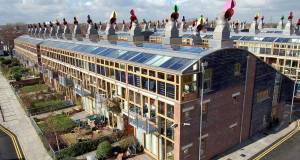 Dr Catrin Maby OBE
Dr Catrin Maby OBE
- Blogs
- Posted
Mainstreaming retrofit – a massive missed opportunity
This article was originally published in issue 43 of Passive House Plus magazine. Want immediate access to all back issues and exclusive extra content? Click here to subscribe for as little as €15, or click here to receive the next issue free of charge
In delivering home energy advice and retrofit programmes, there is an important practical distinction between types of measures. On the one hand, there are those that you can do as one-offs, because they can be dropped into or onto the existing structure and services relatively easily – such as putting insulation in the loft, fitting draught strips to doors and windows, installing cavity fill insulation, upgrading a boiler and heating controls, and installing solar panels. On the other hand, there are measures which are much more intrusive, both to the occupants and to the building: solid wall insulation, replacement windows, and underfloor insulation.
Something else stands out about this second set of measures: there are often details which require a wider set of building skills than those of the installer trained for a single measure. This is even more obvious when you try to tackle sloping ceilings and the range of traditional window types to be found in UK and Irish housing. You also need to see the totality of the building to seek out the potential cold spots, take care to ensure adequate ventilation, and consider moisture movement, concerns frequently highlighted by those involved in retrofitting older buildings. This is further complicated by the fact that older homes tend to have had bits added to them over time, so that each one is different.
Back in the nineties in Birmingham, I worked with the council’s urban renewal department to update their approach to energy efficiency in renewal area programmes. By exploring all the nooks and crannies of some of the big old town houses, I was able to point out several features that could easily be insulated, such as the attics on each side of a loft room, the floor above the side ‘entry’, and the suspended timber floor to the front living room. In those days, we were also replacing gas fires with gas central heating. So, the work involved carpentry, plastering, decorating, plumbing and gas work. Later on, I coordinated a retrofit programme for a group of local authorities in Gloucestershire, and the mix of skills needed extended further to include solid fuel and biomass heating, solar thermal, PV and heat pumps – and working with stone as well as brick.
I started to doubt the value of energy retrofit as a ‘green’ industry, separate from everyday building work on existing homes. Surely we were missing major opportunities for retrofit when people were getting other work done? I decided to research this as a PhD, as I wanted to understand home energy retrofit from the perspective of mainstream building tradespeople. Earlier research by Gavin Killip indicated that the UK home ‘repair, maintenance and improvement’ (RMI) market was a thriving, multi-billion pound, demand-led industry.
Investigating the characteristics of the contemporary RMI industry, it seems that it is dominated by sole traders and microbusinesses, tending to work in a limited geographical area, and getting much of their work through word of mouth and community networks. What my interviewees told me was that they collaborated through informal networks to bring together the different trades needed for each project, so avoiding the risk and hassle of having permanent employees. But this requires someone to coordinate each job, to bring people together and liaise with the customer – and that someone is thought of just as a ‘builder’, offering general building services.
These ‘general builders’ play a key role in terms of what work is decided upon in practice, they are potentially even more influential when recommended by others, and so start from a position of trust. They could be the frontline in promoting and delivering home energy retrofit – so we need to make sure that they have the necessary up-to-date knowledge and skills to do so. But it turns out that there is no clear definition of this as a trade in the UK – and hence no specific qualification or educational pathway. Qualifications and college courses are specific to individual trades, such as carpentry, joinery, bricklaying, electrical services and so on. The builders I spoke to had developed a wide range of skills, but had to source their learning in multiple ways, building up from being a carpenter perhaps, or bringing transferable skills from engineering or project management.
Anecdotally, builders are currently all flat out with work, in spite of the disastrous economic climate. The demand for RMI work is huge – and we are doubtless still missing opportunities every day to maximise the energy retrofit that could be included in this work. We should be creating a tailored qualification for the role of an energy retrofit-skilled home RMI builder – and celebrating it as a key job for a young person to train for. One which I suspect will keep them busy for the next 30 years
Dr Catrin Maby OBE
Dr Catrin Maby OBE has worked on home energy advice and retrofit since setting up an energy advice service for London tenants in the 80s, going on to help local authorities to develop energy efficiency aspects of housing renewal programmes, and affordable warmth and climate change strategies. From 1999 to 2015 she led Severn Wye Energy Agency, and she has since worked on research and policy in the UK and EU, including PhD research on the role of mainstream building trades in retrofit. She is a Monmouthshire County Councillor, and cabinet member for climate change and environment.
Related items
-
 An early green building in a changing Ireland
An early green building in a changing Ireland -
 Bedding sustainability into British buildings: Bioregional’s BedZed
Bedding sustainability into British buildings: Bioregional’s BedZed -
Is shared equity a bridge too far?
-
 Enniskillen passive house camp attracts international audience
Enniskillen passive house camp attracts international audience -
Awaab Ishak’s death shows that building physics are a life and death matter
-
 Healthy Homes Ireland launches indoor environmental quality report
Healthy Homes Ireland launches indoor environmental quality report




